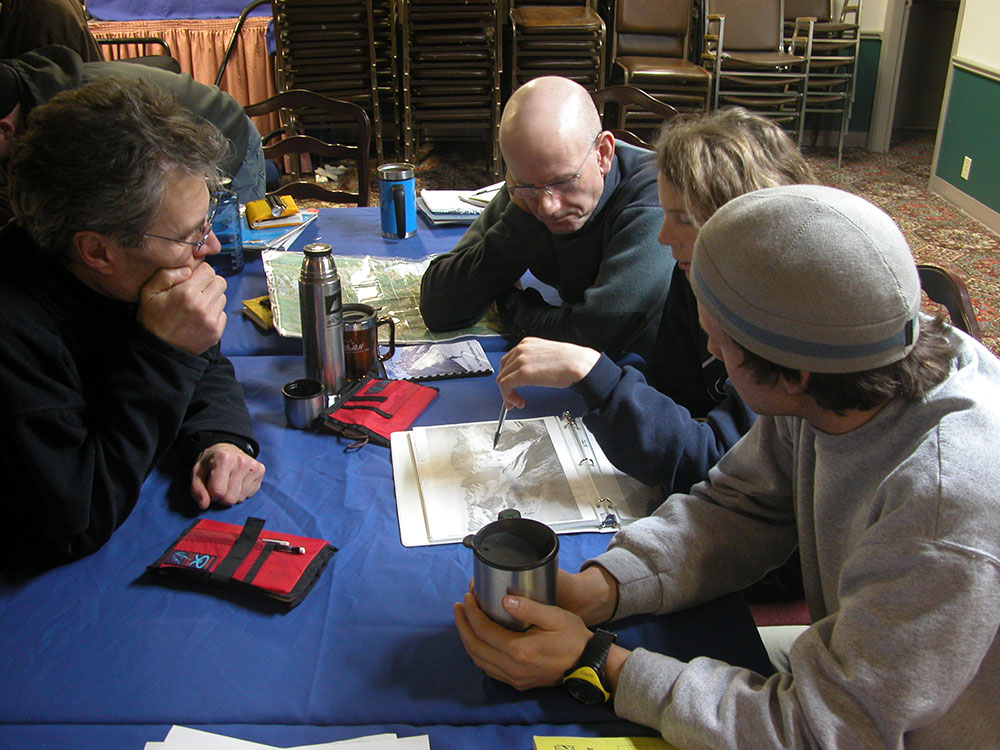Notes From a Pro: The Day End Debrief
For most backcountry skiers, the indoor focus of our avalanche risk management is the pre-trip plan and hazard forecast. “Given today’s hazard, where are we going to go?” and, “How do we plan to manage the risk?” are the two pre-emptory questions. Once safely home, we wrap the day up with a celebratory beer and a self-congratulatory Instagram post, and start texting our plan for the next outing.
However, the standard for the military, business, avalanche operations, and avalanche education courses is to end the day with a debrief and reflection on the day’s decisions. As part of Powder Cloud’s Timeless series, we thought we’d reprint “The Day End Debrief,” first published in The Avalanche Review, the venerable publication of the American Avalanche Association.
Reprinted with permissions, The Avalanche Review, 2018, 36.3. editor Lynn Wolfe, The American Avalanche Association 2018:

The Day End Debrief
A daily summary and debrief is a critical component of avalanche risk management. Individual and group debriefs should be encouraged at all levels, from the recreational level avalanche course to the avalanche worker.
The importance of a day end debrief becomes clear when identifying the objectives:
- Document and summarize today’s conditions.
- Review today’s decision and improve today’s plan for next time.
These objectives provide closure to the day’s decision-making process and ensure that our daily hazard and risk forecast isn’t left hanging as speculation. The debrief provides opportunity for feedback on whether the risk was effectively and safely managed, and identifies a strategy for improvement.
1. Document and Summarize Conditions
What did we see?
How was it different than what we thought we’d see?
Are things getting better or worse?
Documentation allows us to remember and reference; and to identify trends and assess the accuracy of our forecast.
Questions promote group discussion and individual reflection. Identifying what we know, what we thought we knew, and concluding with what we still don’t know (targeting uncertainty) helps us gain wisdom.
Feedback informs opinion. Our perspective is informed by observations that “ground truth” our hazard assessment. However, our observations may add up to a few data points, and experience and extrapolation are required to form an accurate analysis. It is not uncommon for two experienced observers to travel in the same drainage and come home with a different hazard assessment. In the context of providing feedback, the snowpack can be notoriously silent, and an informed perspective from experienced colleagues is essential to a well formed opinion. We know that “recognition primed decision or response” (from Klein and others) is integral to our decision-making process. The Catch 22 is that “our intuition is only correct to the extent that the historical reference connects the right facts to the right reference” (Antonio DeMasio, UCLA Brain and Creativity Institute. Also, from Klein, Hogarth and others).
Reaching consensus during a group discussion of how the weather is affecting the hazard, what are the distribution and sensitivity of the primary problem, what are the sources of uncertainty, and how the hazard is trending, helps both the worker and recreationalist connect the right facts to the right circumstance and properly inform our future decisions.
2. Review Today’s Decisions: Improve Today’s Plan
What were the strengths and shortcomings of today’s plan?
Where were we most at risk?
What could we have done better?
Whereas part one’s summary involves observation, analysis, and learned interpretation, part two’s risk evaluation asks face to face questions that beg for honest appraisal and self-evaluation.
As professionals we plan to limit our exposure and deliberately build in margins of safety (usually by ensuring that our terrain use strategy reflects our uncertainty). One way to identify whether we are operating consistently within an acceptable level of risk is through a daily review of our decisions.
Providing honest feedback to colleagues or ski touring partners is never easy. A few suggestions can help:
- Feedback carries more weight when delivered soon after observation (Peter Renner, “The Art of Teaching Adults”). Debrief as soon as you are back in the office, post control route, or post ski touring trip, and before folks are distracted by other tasks.
- Formalize the debrief into a standard post trip event (i.e. follow a debriefing format). Ensure everyone buys in, expects it, and verbalizes that they are willing to engage. Ensure the group is in a comfortable setting without distractions (no smart phones).
- Rotate the role of facilitator. Participants are less likely to take feedback personally when they understand that the formal questions are not personalized. The pre-written questions are directed at the group process, not at the individual.
- Ensure first that each individual wants and requests any personal feedback on their decisions or actions. No one appreciates unsolicited feedback, especially when it’s personal.
- Comment only on what was observed or what happened. Stick to the facts. (For example, “during the ascent, more than one person was exposed to the slope”). Leave the speculation on “reasons why” to the professional psychiatrist and their couch. (For example, “you were quite fatigued which may have affected your ability to make good decisions or come up with a better option”). Inferences or hunches can be interpreted as a personal attack.
- Take “near misses” seriously and document and debrief near misses as you would an accident—employing a professional to provide counsel if necessary. The result can be due as much to chance as any deliberate action. Operation supervisors and trip leaders alike should not underestimate the possibility of post event stress that can affect worker relationships, job satisfaction, and friendships.
Lessons learned stick when they can be immediately applied or visualized. “If we went back to the same slope in the same conditions tomorrow, what would we do differently?” is a more specific and potentially more valuable rewording of the broad question, “What could we have done better?”


